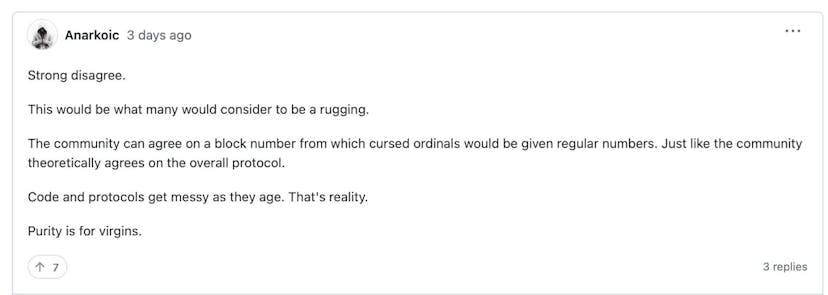Bitcoin Ordinals Creator Casey Rodarmor Has Proposed To Make Ordinal Numbers ‘Unstable’ and Renumber All Existing Inscriptions
The Ordinals protocol took the Bitcoin network by storm this year, presenting a novel system of indexing digital assets on the blockchain. However, a seemingly simple task of managing the index for these Ordinals has sparked intense controversy, the outcome of which stands to reshape the landscape of this growing ecosystem.
Ordinals first gained rapid adoption across the Bitcoin network based on the protocol’s introduction of indexed assets attached to one or more Satoshis, the lowest denomination of BTC.
However, indexing Ordinals is not exactly a straightforward process, and some of those complications result in instances where certain inscriptions, for various reasons, are not properly indexed. Those Ordinals that were inscribed correctly but indexed improperly are dubbed “cursed ordinals,” and the coder behind the Protocol, Casey Rodarmor, says the logic surrounding their upkeep “is a source of bugs and complexity.”
Now, a debate is raging over whether to make Ordinal numbers “unstable,” which could have a substantial impact on the value of early inscriptions.
Cursed Ordinals
Certain circumstances in the Ordinal protocol, such as minting multiple inscriptions in a transaction, altering reveal inputs or changing the number of fields, or even committing multiple inscriptions to the same satoshi cause discrepancies.
When such discrepancies occur during the indexing of an inscription that earlier protocol versions cannot recognize, those inscriptions are ascribed a negative number – a so-called cursed Ordinal.
However, the introduction of cursed Ordinals has led to a series of issues, according to Rodarmor, such as the inability to discern the creation order from the inscription number, an increased potential for bugs, and added system complexity.
There are additional challenges surrounding the necessity for the community to coordinate and “bless” particular cursed inscriptions, which refers to assigning them positive numbers after a specific block height.
Mixed Blessings
Rodarmor’s plan is to simplify the Ordinal codebase by “blessing” cursed Ordinals to fold them back into the protocol’s main sequence, effectively renumbering the assets.
“I propose that we make inscription numbers permanently unstable, and bless all cursed inscriptions, both retroactively and on an ongoing basis,” said Rodarmor in a blog post.
The alteration would renumber the existing Ordinals and make all numbering for the protocol unstable. While marking a departure from the initial intention behind inscription numbers, Rodarmor’s fix aims to ensure the longevity and adaptability of the protocol’s codebase.
However, not everyone supports the proposed change. The existing numbering system underpins several Ordinals projects, and many collectors have made acquisitions based on the perceived value of low-indexed assets.
The Opposition
A central part of the controversy lies in the proposed shift from stable to unstable inscription numbers. Opponents argue that this would not only disrupt the established order but also diminish the intrinsic value of their collections.
One example is the “Hell Raiders” collection, strategically placed in the 666k range. The re-indexing would push these out of their iconic position, potentially eroding their cultural and collectible essence, according to project lead Knox.
“The heart of the contention lies in a culture versus protocol disagreement. The shifting of all positive inscription numbers may negatively impact many as it would compromise the collectibility of Ordinals many have invested time and resources in,” said Knox.
Middle Ground
On Github, a number of Ordinals ecosystem players are mulling over Rodarmor’s proposal, some of whom approve of the fix, while others are calling it “rugging.”

One potential compromise, originating from developer and founder of Taiwan-based centralized exchange, Maicoin, Danny Yang, takes into account the potential cascading effects of an Ordinal renumbering.
Impacted Ordinals from the era of cursed inscriptions might be preserved via a snapshot taken before the block height where numbers become permanently unstable across the protocol, said Yang.
Among the methodologies recommended by Yang is to identify an ultra-efficient mechanism to craft a generative inscription capable of returning the original inscription number. This would ensure a comprehensive snapshot while minimizing the block space consumed.
Perhaps a more hands-on approach, Yang also suggested users might have the option to reinscribe their unique inscription number in a prescribed format. Since only a subset of users might be genuinely concerned about the renumbering, this method might not lead to an overwhelming number of reinscriptions.
Furthermore, this approach ensures that the reinscribed number remains tied to its original inscription, eliminating the need for a full snapshot for indifferent users. Yang also advocated a combined approach of both methods.
- SEO Powered Content & PR Distribution. Get Amplified Today.
- PlatoData.Network Vertical Generative Ai. Empower Yourself. Access Here.
- PlatoAiStream. Web3 Intelligence. Knowledge Amplified. Access Here.
- PlatoESG. Carbon, CleanTech, Energy, Environment, Solar, Waste Management. Access Here.
- PlatoHealth. Biotech and Clinical Trials Intelligence. Access Here.
- Source: https://thedefiant.io/ordinals-community-grapples-with-numbering-controversy




